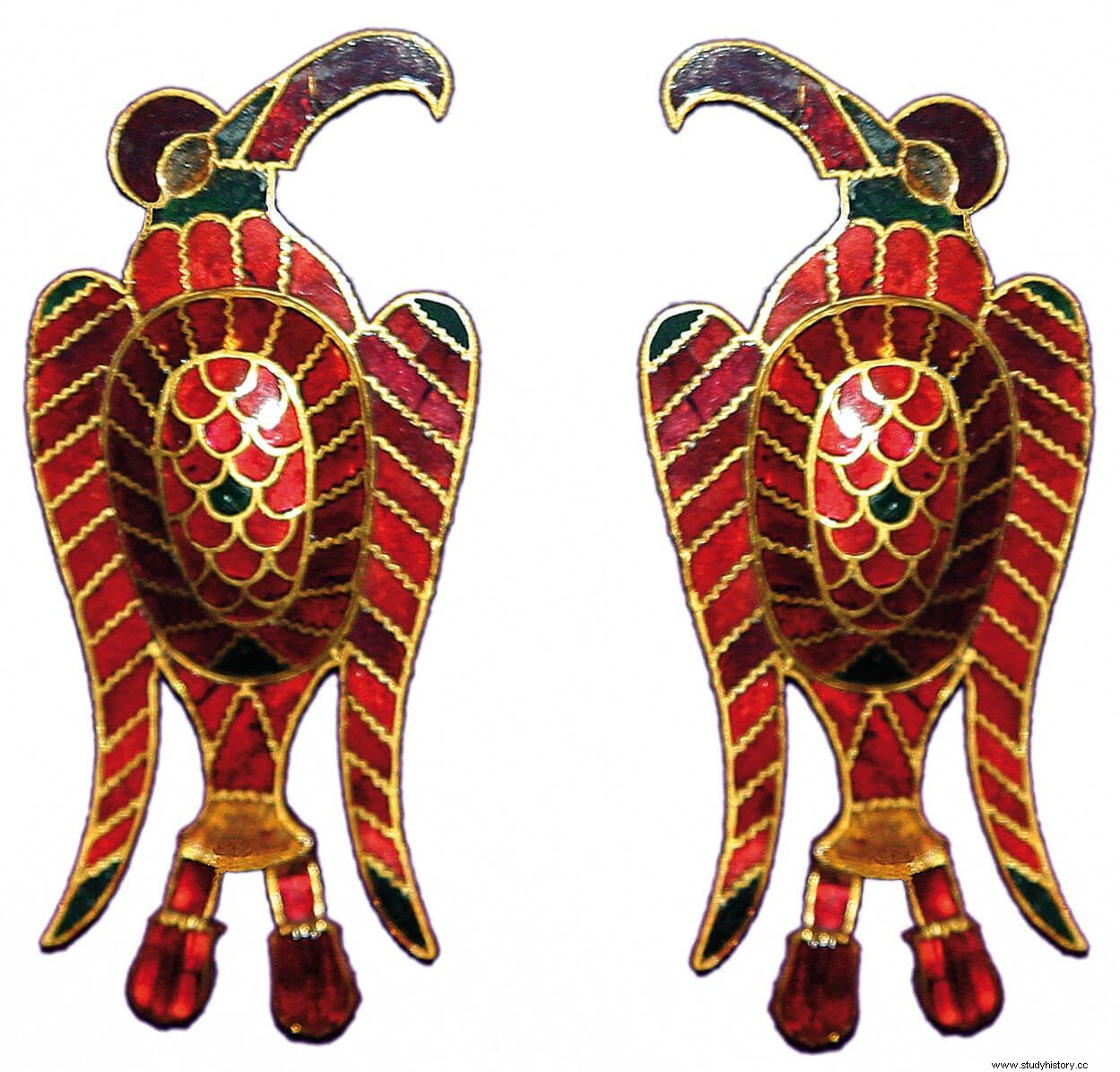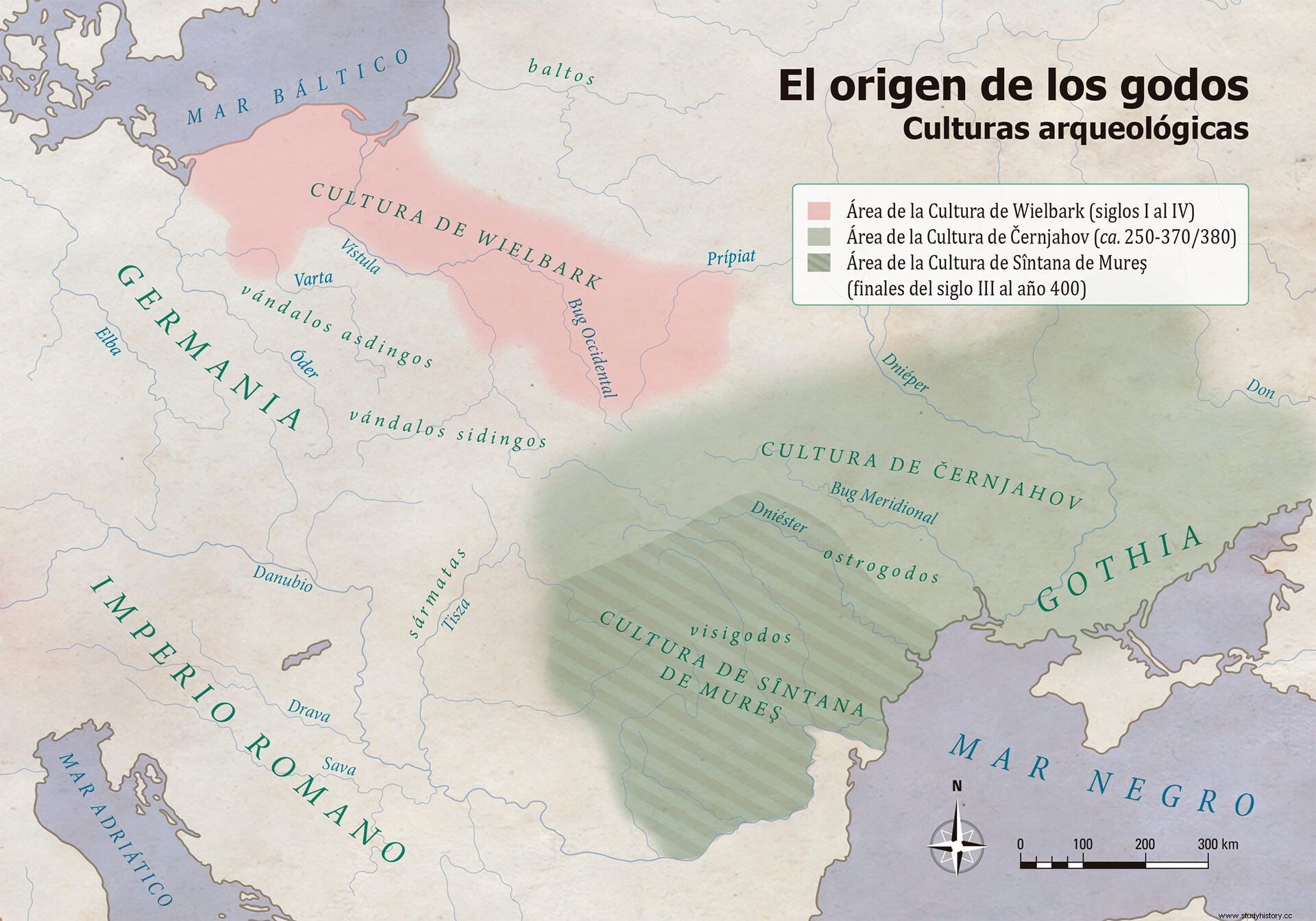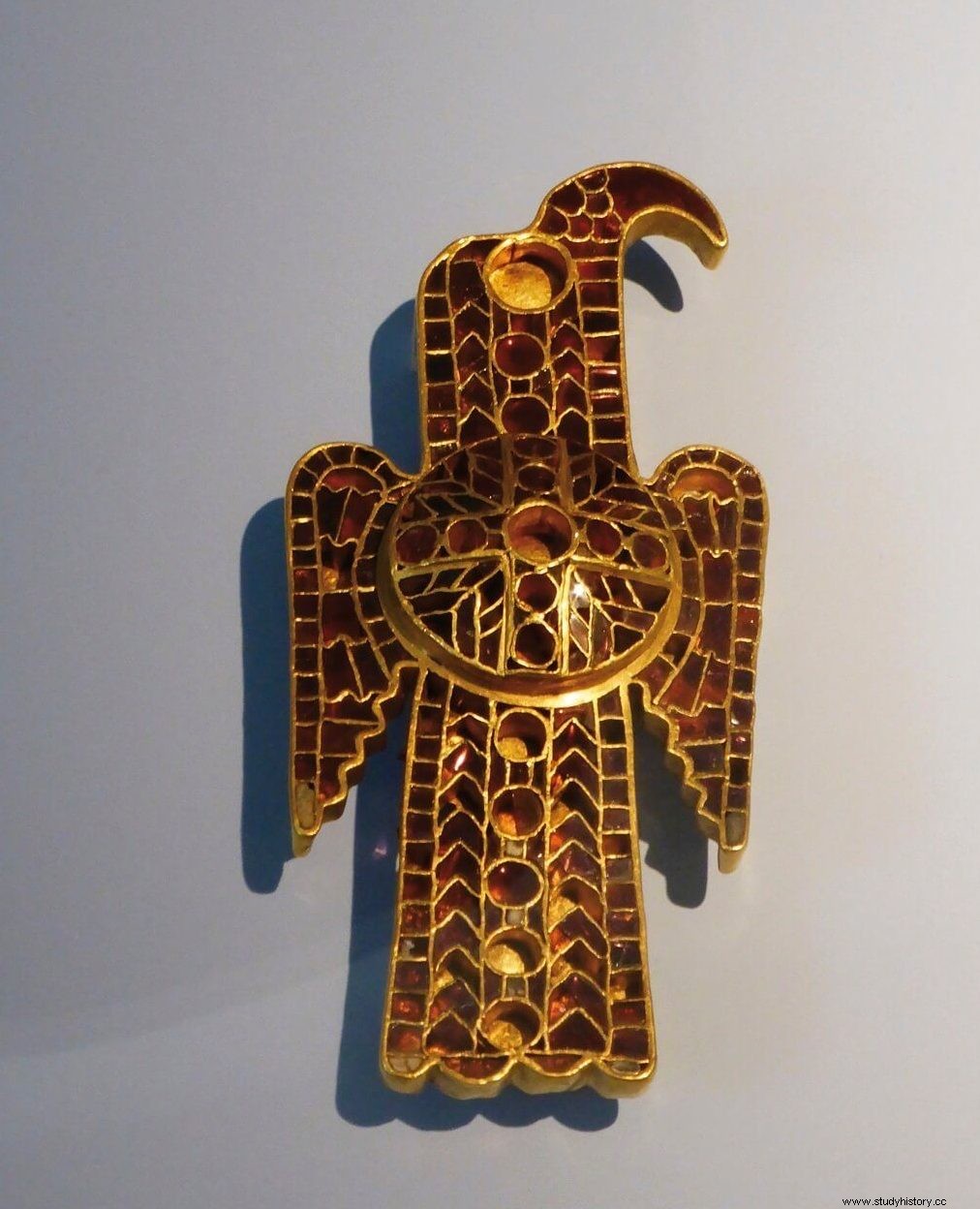
The name “goths ” is frequently quoted in ancient literary sources, both in Greek and Latin, from the 1st century AD. C.:in Strabo (Geography VII.1.3); in Pliny (History Natural IV.11.99) in the form of guttones; in Tacitus (Germ ania 44.1) calling them gothones and gotones (Annals II.62.2); and in Ptolemy (Geography III.5.8). The inscription on a gold ring found in Pietroassa (Romania), from the second half of the 4th century, includes the spelling gutani . The form gothi appears only from the third century, used by the Greek and Latin authors , referring to the presence of Gothic contingents in Gordian's army in the middle of the 3rd century (year 242).
According to Jordanes' account (Getica V.38), the Goths would have settled on the Pontic coast in the period of endless civil wars that followed the death of Alexander Severus, carrying out a series of victorious military campaigns against the Vandals, Marcomanni and Quado-Swabians, peoples settled in the middle course of the Danube. Around 250 the Goths, led by Argaito and Gunteric, in alliance with the Taifales, the Asdingo Vandals and other peoples cross the Danube; a fact that would be repeated the following year, under the command of the Gothic king Cniva. The numerous presence of Roman legionnaires among the Goths – disaffected soldiers quartered in the limes Danubian–, explains the strictly Roman organization, with a three-line front, of the barbarian army in the decisive battle of Abritus (251), where Emperor Decius would meet his death along with his son. It is at this time that a significant process of romanization is evident in what is known as the Černjahov culture , linked precisely to the presence of Roman soldiers among these barbarian peoples.
Throughout the second half of the third century and the first half of the fourth century, a series of changes, internal and external, took place in the heterogeneous set of peoples known as Goths, which are also evident in other groups, and which have been reflected both in the texts themselves and in the archaeological record. On the one hand, graves with weapons, both offensive and defensive, are found in the funerary world, in line with a marked process of militarization of the barbarian elites. Something that the sources seem to corroborate in the second third of the fourth century, since the Goths of Hermeneric led, at that time, a broad federation of barbarian peoples installed between the Danube and the Don (geographical area that Latin authors call the “European Sarmacia ”, the Scythia or Gothia), forming a powerful empire. On the other hand, the archaeological documentation also shows a strong influence of the Roman civilization. The elements of clothing, dishes and weapons found in the tombs of the third and fourth centuries, in southern Russia and in the lower course of the Danube, show the progressive Romanization of the Goths .
Archaeologists who study the barbarian world have coined the concept of "archaeological culture" to try to differentiate the various groups of peoples, thus avoiding avoiding the controversial and pejorative concept of "ethnicity" . As far as the Goths are concerned, there are two archaeological cultures that are associated with what the Roman authors called gothi in the middle of the 3rd century - the Wielbark culture and the Černjahov-Sîntana culture of Mureş; coincident, precisely, with the first two waves of migratory movements that are documented for that moment.
Wielbark culture
The Wielbark culture would extend from the 1st century to the middle of the 3rd century, staying in its initial spatial area around the Vistula until the beginning of the 5th century, with Scandinavian influences consisting of mixed funerary practices (incineration/inhumation) and circular stone ritual constructions. Some authors do not hesitate to openly propose a Scandinavian origin for the Amalos dynasty (to which Hermeneric belonged) despite the clear influences from the Pontic area, perceptible in the jewels, shields and spears. This culture denotes, however, a great heterogeneity for the diversity of peoples that compose it, originating from both the Scandinavian area and the continent, the Goths not being the only ones, since the Gepids, for example, make up a very powerful nucleus within it. In fact, the Wielbark culture materialized towards the end of the 1st century, within the framework of a larger political entity that the texts call Guttones, associated with what is known as the "Gothic-Gepid culture".

The Wielbark culture is known primarily to from their necropolis and it is characterized by its large funerary complexes of a mixed nature with a circular stone plan, with differentiated areas for cremation and burial; the absence of weapons and the scarcity of elements of clothing in the male tombs; the existence of a characteristic type of clothing in female tombs, consisting of a pair of bronze fibulae, worn on the back and/or chest, to close a cloak (peplos ), complete with large bronze belt buckles and necklaces set with precious stones. The end of the Wielbark culture in Pomerania would be characterized by a progressive stylistic differentiation between male clothing (more subject to foreign influences, especially from the Roman world) and female clothing (much more "conservative" and less permeable).
In the spatial scope corresponding to this archaeological culture, the literary sources mention a whole series of peoples, in addition to the Goths, who could show similar traits:“East Germans”, such as the Rugi, Semmones, Vandals, Gepids or Longobards; or “West Germans”, like the lugi . Archeology shows a migratory movement from the end of the 2nd century –also included in the texts–, from the Vistula to the southern European sector, simultaneously with the emergence of the Černjahov culture.
The culture of Černjahov-Sîntana de Mureş
The so-called Černjahov culture, documented in the mid-3rd century from the eponymous Ukrainian necropolis, would belong to the sociopolitical sphere made up of the “Gothic federation” – led by Hermeneric in the 4th century – and would develop until the beginning of the 5th century. At the beginning of the 4th century, it spread to what is now Romania, calling itself there the Sîntana de Mureş culture . For some authors, the emergence of this "culture" would reflect the separation around the year 291 of the two main groups of Goths:the tervingi-vesi (Visigoths or “West Germans”) and the greutingi-ostrogothi (Ostrogoths or “East Germans”). The Černjahov culture is located on the Black Sea coast, between the mouths of the Danube and the Don, present-day Ukraine, Moldavia and Transylvania.
The necropolis that gives its name to this archaeological culture, Černjahov (located in the middle Don basin), was discovered in 1899, and since then the debate around its ethnic affiliation has been constant:while for German researchers it would be a culture “typically Germanic ” (it was even used by the Third Reich to justify the annexation of Ukraine), for Russian and Romanian archaeologists it would be the precedent of the Slavs . The existence of characteristic elements of the Wielbark culture linked to groups of "Germans", including the Goths, is visible in some materials such as fibulae and pottery not made on a wheel. Both cultures, both that of Wielbark and that of Černjahov, share the same type of female clothing, cremation coexisting with burial as funerary practices, while weapons would be practically absent in the tombs.
However, certain elements are considered characteristic of the Černjahov culture, such as the large Stalhaus type wooden houses or semicircular bone combs, and are found among different peoples belonging to the barbarian realm. While other indicators, such as certain forms of pottery not made on a wheel, fibulae, metal mirrors, stone dwellings or burials with niches dug into the sides, would constitute customs of Iranian origin and even of Scythian or Sarmatian-type populations of the steppes near the Black Sea. To this would be added clear influences of the Slavic type (wooden houses with a bottom dug into the ground) and Thracian (incinerations in urns). One of the most determining characteristics of the Černjahov culture with regard to the funerary world ‒besides the surprising absence of what are known as “princely tombs” or of elites‒ is the practical inexistence of iron objects in the tombs and, specifically, weapons. This distinctive feature is not a trivial fact, since in the so-called "Visigothic necropolis" of the Iberian Peninsula the absence of weapons in burials is a constant.
We are, evidently, facing multiethnic population groups subjected to strong processes of miscegenation and acculturation over time, something that would correspond to what the texts indicate regarding a federation of peoples barbarians who are generally identified with the Goths, settled, as we have seen, in this wide geographic sector since the middle of the third century.
The name of Goths, as Michel Kazanski points out, has a political and cultural significance, Not ethnic at all. The deep and intense romanization of the Černjahov culture, from the end of the 3rd century, evidences close and fruitful contacts with the Roman world (result of pacts and alliances), together with the integration of peoples belonging to the "Gothic federation" in the Roman army (confirmed by the presence of weapons in the necropolis of the limes Danubian). If we add to this the growing strength of the Hermeneric empire among the various barbarian peoples, the extraordinary diffusion of the Černjahov culture is explained not only in Central Europe, but throughout the West, a phenomenon in accordance with the relevance that the "Gothic federation" will have. in the process of what are known as “great migrations ”. Indeed, the period between the end of the 4th century and the beginning of the 5th, from the point of view of archaeological sources, evidences a diaspora of objects belonging to the Černjahov culture. It is also the moment in which the appearance of characteristic objects of what is known as "Danubian fashion" is verified, originating in the middle course of the Danube to spread widely among the barbarian aristocracy and the Roman elites from the end of the fourth century and until the first half of the next. Some of the clothing elements characteristic of this culture, particularly in its final phase - such as the large pair of fibulae with a semicircular head and elongated foot, accompanied by a large belt buckle, characteristic of female tombs - would be, for some researchers, elements originating from the Černjahov culture.

The ultimate disappearance of this omnipresent culture is considered It took place between the years 400-410 and would be directly related to the exodus and/or Gothic diaspora in the West motivated by the pressure exerted by the Huns from 375 with the collapse of the Hermeneric empire. A fact that would have meant a significant depopulation of the entire sector north of the Black Sea and in the final stretch of the Danube (see "The Huns ” in Ancient and Medieval Wake Up Ferro #1). Therefore, it can be affirmed that the final phase of the Černjahov culture, in the period immediately prior to the “great migrations” (between the last third of the 4th century and the beginning of the 5th), generally associated with the Gothic sphere, evidences the same elements that define it from its beginnings, always maintaining the same homogeneity in the material register. At the same time, influences from other areas are verified that would be indicating the arrival of peoples from the center and south of present-day Poland (an area related to the Vandals) and that could have accompanied the Huns from the year 375.
The archeology of the Goths
What, ultimately, does archeology contribute to the knowledge of the Goths? Through the concept of “archaeological cultures”, an attempt has been made to document, as we have seen, the supposed Gothic migration from Scandinavia to the final stretch of the Danube and north of the Black Sea, using the ambiguous ethnographic descriptions of Greco-Roman authors from the 1st century BC. Thus, the Wielbark culture is associated with the Goths, although in the geographical area attributed to it, at least three different population groups would be related to it:the Goths, the rugi and the Gepids. Regarding the culture of Černjahov, it is traditionally considered as the nucleus of what would be the “East Germans” (Ostrogoths); although, as we indicated, the culture of Černjahov would disassociate, fundamentally from the fourth century, between present-day Moldavia and Romania, giving rise to a differentiation between what the sources call "Thervingian-Visigoths" (Sîntana de Mureş) and “greutungo-ostrogodos” (Černjahov).
This method of analysis is based on a systematic association between the geographical area identified with the settlement space of an ethnic group mentioned in the ancient authors and the archaeological "culture" documented through the material search in that same area. It must be taken into account that we are talking about different sources, categories and methods of analysis that are often interrelated as if they were comparable, when heterogeneity and the absence, therefore, of unequivocal common features of identity is what characterizes all these population groups. Visible heterogeneity not only in the various names that ancient authors use to refer to the Goths (gotones , guttons , gouts , guthons ), but in the impossibility of proving a historical continuity for six centuries, until the moment in which Jordanes writes his Getica in the sixth century.
This historical discontinuity It would be explained by the various processes of ethnogenesis –quasi-constant constitution of peoples through mechanisms of integration and assimilation– of the Goths and, particularly, by the impact of the Huns on the peoples settled north of the Black Sea and the lower Danube, which would cause and/or stimulate its dismemberment (according to Jordanes' account) towards the end of the 3rd century into the two great groups that would give rise to the Visigoths and Ostrogoths . At the end of the 3rd century, the Visigoths would include Alans, Huns, Balts, and Taifas; that is, a large multi-ethnic group that would be in the military service of Rome and that was installed based on a foedus , a pact, in the year 382 in the Roman province of Thrace, in the year 418 in Aquitaine and, from the year 507, after the defeat of Vouillée, in Hispania. The Ostrogoths, under greater influence of the Huns, would remain in the Balkans and in Pannonia until Theodoric pushed a good part of them to Italy, between the years 497/498, thus setting up an independent kingdom until the year 552 (see “Narses and the conquest of Italy:552-554 ” in Ancient and Medieval Wake Up Ferro #18).
The archaeological record, in the case of the Ostrogoths in Italy and the Visigoths in Hispania, does not allow them to be differentiated with respect to what could be attributed to other population groups of barbarian origin or, even, to the Hispano-Romans themselves. Inexplicable –or not so much considering the ineffectiveness of the archaeological record when it comes to establishing “ethnic identities”– would also be the absence of “Visigothic necropolises” in Aquitania, settlement area of the Goths in the year 418. The term Goths itself could refer, exclusively, to how Rome called the group of peoples who inhabited the south of present-day Russia and the north of the final stretch of the Danube towards the middle of the century. III. A lack of definition, both in the material and in the textual record, which does not allow, in short, either to trace a centuries-old history of the Goths from their supposed Scandinavian origins, or to archaeologically document their successive migrations in a differentiated way with respect to a whole series of elements common to other groups of barbarians, and particularly their elites.
Bibliography
- García Moreno, L. A. (1992):The keys of the Germanic peoples, 500 a. c.-711 . Barcelona:Planet.
- Heather, P. (2010):Emperors and Barbarians. The first millennium of European history . Barcelona:Criticism.
- Kazanski, M. (1991):Les Goths (Ier-VIIe s. ap. J.C.) . Paris:Errance.
- López Quiroga, J. (2006):Gentes Barbarae. The Barbarians, between myth and reality . Murcia:University of Murcia
